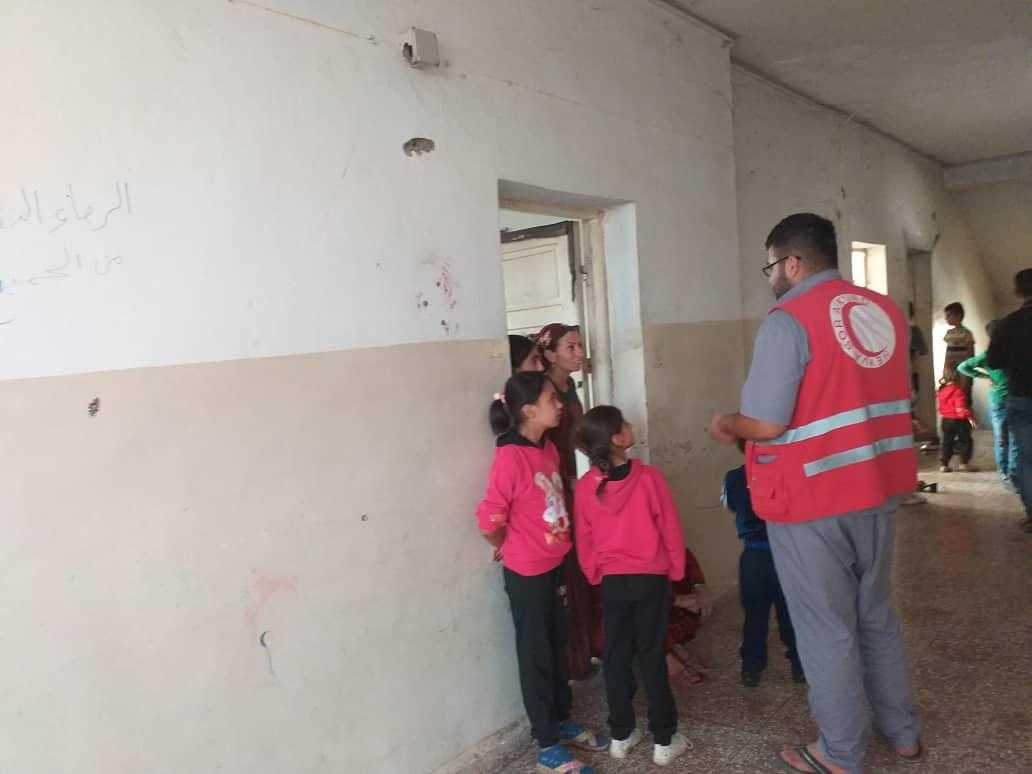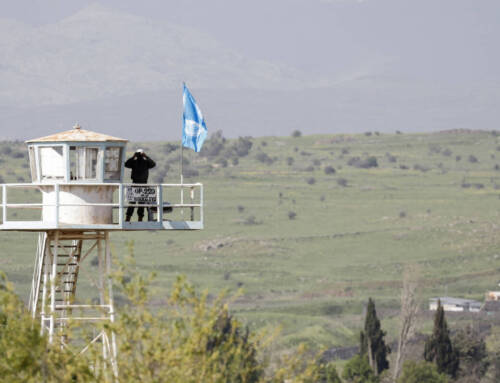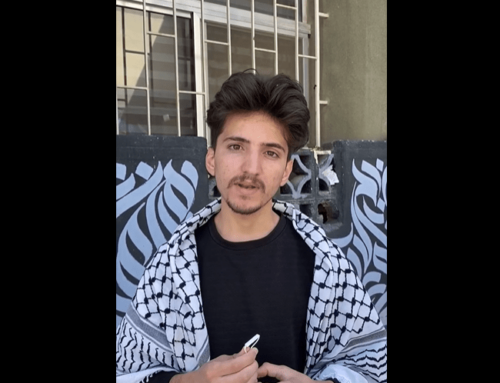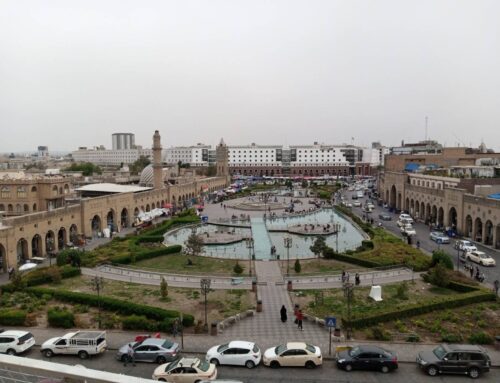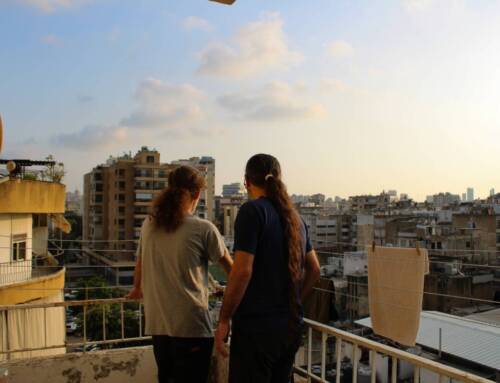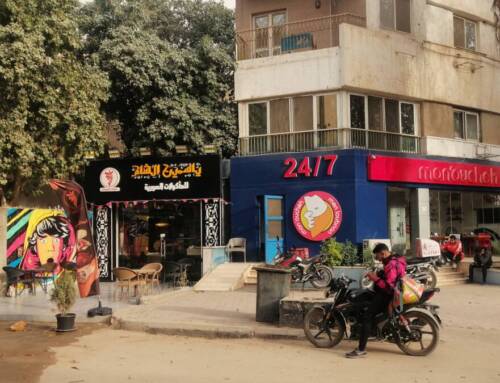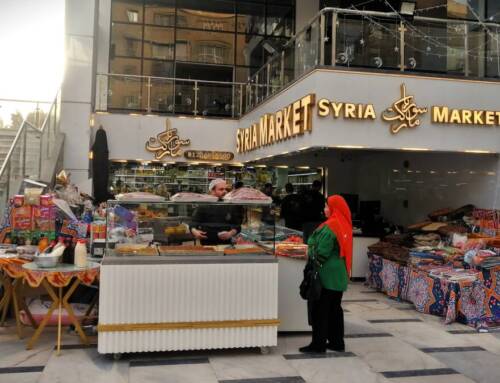‘The Situation is miserable’: IDPs caught between Turkey and Damascus’ forces
Massive displacement caused by Turkey's offensive in northeast Syria has created a massive humanitarian crisis, trapping civilians between Turkey and Damascus.
17 October 2019
A Kurdish Red Crescent employee talks to displaced children hosted in a school in Hasakah, 12/10/2019 (Kamal Derbas)
Amman- In just one week, the ongoing Turkish military operation, “Operation Peace Spring,” has displaced hundreds of thousands and destroyed critical civilian infrastructure in northern Syria, resulting in alarming shortages of food and water.
“We left the first day that Ras al-Ain was shelled,” Xemgin Mamoste Kurdi told Syria Direct. “The situation was very dangerous due to the airplanes indiscriminately shelling the city.”
Kurdi, 34-years old, is one of more than 300,000 people who have fled the Turkish-backed Syrian National Army’s (SNA) advance into northeast Syria, according to the Syrian Observatory for Human Rights (SOHR).
Most Internally Displaced Peoples (IDPs) come from border towns, such as Tal Abyad and Ras al-Ain, which have been subject to shelling and unverified reports of kidnappings and execution of civilians by SNA fighters.
“The women, elderly and children are sleeping in the streets and artillery is falling on their heads,” Kurdi said.
The recent massive wave of displacement puts further pressure on a region that was “already stretched to breaking point” from hosting 390,000 IDPs from other regions in Syria, according to a March 2019 UN report.
“The humanitarian situation is miserable… How can I explain it to you? All of the international organizations that were here left: IRC, CARE, ACTED, all of them,” a member of the Kurdish Red Crescent stationed in the border town of Amuda in Hasakah Province, Kamal Derbas, told Syria Direct.
“There were more than 100 international organizations here, but they left as a result of the Turkish shelling,” Derbas said.
Like Kurdi, many IDPs either fled from Tal Abyad and its surrounding villages, heading through Ain Issa towards Raqqa city or from Ras al-Ain (known in Kurdish as Serekaniye) and its surrounding villages to Tal Tamr, some 30 kilometers away, according to Derbas. Most sought shelter in Hasakah city after passing through Tal Tamr and Raqqa.
Most IDPs have relied on relatives for accommodation, staying with cousins or other members of their tribes; whereas those without relatives are staying in makeshift shelters in churches and schools, according to Derbas.
“We’re staying with our relatives in Tal Tamr,” Kurdi said. “The situation is not very good as there are battles all around the city and there is not enough aid in Tal Tamr.”
However, the sheer number of people fleeing has overwhelmed the capacity of hosts. Some residents are hosting more than ten families in a single house, Derbas said.
“The main need will be shelter,” the Regional Media Manager for Save the Children, Joelle Bassoul, told Syria Direct. “Overcrowded shelters where civilians [are] displaced have no capacity to respond to emergency needs.”
There are also shortages of key supplies as highways have been cut off by the surrounding fighting. These shortages will only grow more critical as winter approaches, according to Bassoul.
“We need medicine and food, food for children, especially milk and infant formula; there is a huge lack of supply. The trading routes are closed and there’s no milk,” Derbas said.
Further, shelling of civilian infrastructure, including the vital Alok water pumping station, which supplies Hasakah Province, has left civilians to rely on quickly dwindling storage tanks for their water needs.
The recent surge in displaced civilians will only exacerbate the water shortage.
Home is no longer home
Even if IDPs were able to return tomorrow, the homes they would return to are vastly different from the ones they left just a week before. This is primarily due to the Syrian Democratic Forces’ (SDF) recent memorandum of understanding with Syrian government, which allows the latter’s forces to deploy in key positions in SDF-held territory.
“There was a complete exclusion of the [Kurdish] people by the regime,” Kurdi said. “If we don’t have rights, of course, we won’t be able to live with them.”
Even if the SNA is repelled by the joint efforts of SDF and the Syrian government forces, the presence of Damascus’ forces has made many IDPs afraid to return.
“Activists across SDF-held areas are highly concerned about their future,” Elizabeth Tsurkov, a fellow at the Philadelphia-based Foreign Policy Research Institute told Syria Direct. “Many people across areas held by the SDF are wanted by the regime. This includes people who are activists and anti-regime across all ethnicities, [and] includes former opposition fighters who then joined the SDF.”
“They understand that the regime will take over security control in these areas and not simply police its borders to prevent a further Turkish incursion, [which makes them] interested in fleeing,” she said.
Though the current memo of understanding is military in nature and only gives government forces permission to deploy along the Syrian-Turkish border, many suspect that ongoing political negotiations between the SDF and Damascus will result in significant government control over territory currently held by the Kurdish-led Autonomous Administration of North and East Syria (AA).
“The agreement that will be reached between SDF and the regime will likely include security control because this is a consistent demand of the regime,” Tsurkov said. “The SDF does not hold any pressure cards at this moment to be able to prevent this from happening.”
Areas retaken by the regime in other Syrian regions have undergone a process known as “reconciliation,” which meant to give amnesty to those who previously fought against the regime. However, these areas have mostly been characterized by degradation in security conditions and government reprisal against former activists and opposition fighters.
A “reconciliation” form obtained by the Brussels-based European Institute of Peace in July asks those seeking amnesty to state their “involvement in the protests, riots and armed terrorist activities,” as well as their social media accounts, knowledge of “non-Syrian terrorists” and “intelligence agencies,” and details about their relatives’ involvement in anti-government activities.
On Wednesday, tribes in Deir e-Zor protested the prospect of any sort of reconciliation with the regime and a group of civil society activists issued a statement that they will “deny the Assad regime and its Iranian terrorist militias entry into Deir e-Zor under any circumstances.”
On the other hand, if SDF and the government forces are repelled by the SNA, it is likely that the individual Syrian factions that make up the Turkish-backed SNA will take control of border towns such as Tal Abyad and Ras al-Ain, according to Tsurkov.
Fears of a repeat of Turkey’s “Operation Olive Branch” in Afrin, in which Turkish-backed groups facilitated a demographic re-engineering of the town by giving the homes of displaced Kurdish residents to displaced Syrian Arabs originally from Damascus suburbs, prevent many IDPs from returning.
Further, a January UN report asserts that armed groups which were previously backed by Turkey committed war crimes in Afrin.
“If the regime returns… we might return as well if they are open to democracy,” Kurdi said. “[However] if Turkish forces controlled my city, it would be hard to return there.”
“We were hesitant to leave because it’s our home and all our work and history are present in the city,” Kurdi said. “[However,] they want to kill each one of us that returns. Any person from the city or that had been working with the Autonomous Administration, they will kill him. Of course, we can’t return and live with them.”
A reader brought a incorrect URL in the article’s text, which was corrected on 12/11/2019 2:05 PM.

